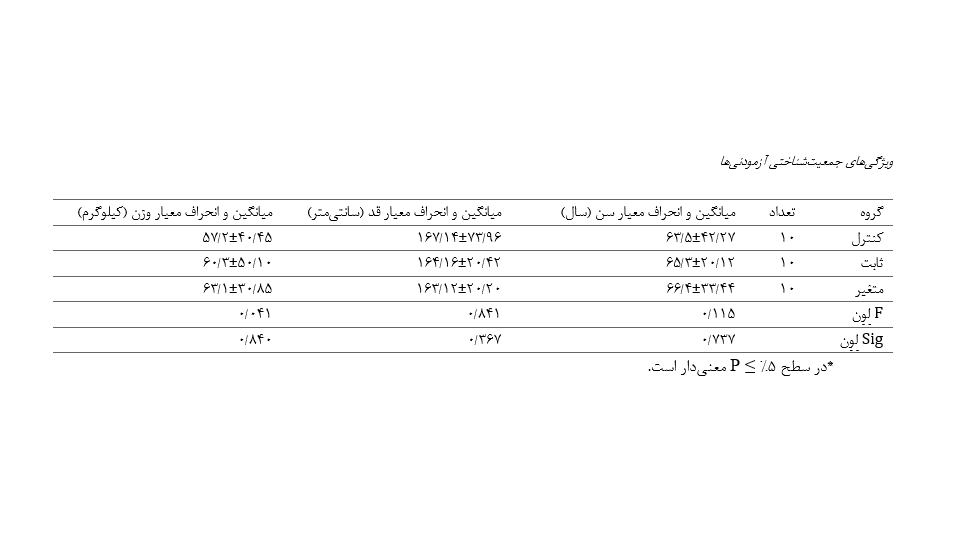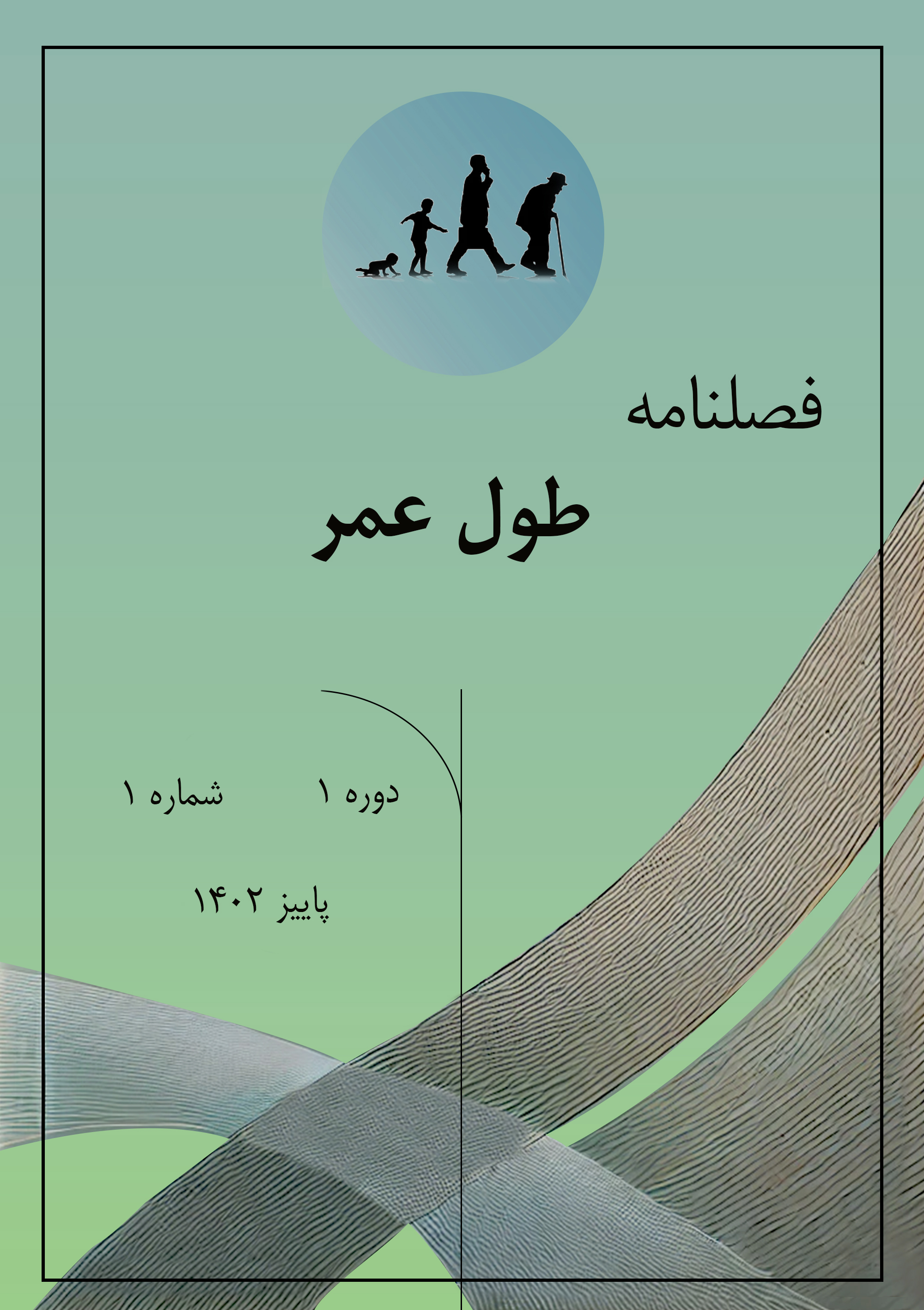تأثیر تمرین تکلیف دوگانه با شرایط ثابت و متغیر بر تعادل ایستا و پویای سالمندان پس از سکته مغزی
کلمات کلیدی:
تمرین متغیر, تکلیف دوگانه, بهبود تعادل, سکته مغزی, بزرگسالچکیده
سکتهمغزی شایعترین و ناتوانکنندهترین بیماریهای نورولوژیک در افراد بالغ است که باعث اُفت تعادل و وابستگی کارکردی میشود. بنابراین، هدف این پژوهش مطالعه تأثیر شیوه تمرین تکلیف دوگانه با شرایط ثابت و متغیر بر تعادل بزرگسالان پس از سکته مغزی بود. پژوهش حاضر از نوع نیمهتجربی با طرح پیشآزمون و پسآزمون بود. جامعه آماری این پژوهش افراد بزرگسال دارای سابقه سکتهمغزی مراجعهکننده به مراکز درمانی شهرستان شوش دانیال بودند. از بین افراد داوطلب 30 نفر به عنوان نمونه انتخاب و به طور تصادفی به سه گروه کنترل، گروه تکلیف دوگانه در شرایط ثابت و گروه تکلیف دوگانه با اولویت متغیر تقسیم شد. یک هفته قبل از شروع مطالعه، اهداف، اهمیت و مراحل پژوهش برای آزمودنی تشریح شد و فرم رضایتنامه آگاهانه توسط شرکتکنندگان تکمیل شد. پیشآزمون تعادل برگ و بلند شدن و رفتن زماندار انجام شد و آزمودنیها به صورت تصادفی به 3 گروه 10 نفری، یعنی دو گروه آزمایشی (تمرین تکلیف دوگانه در شرایط ثابت و تمرین تکلیف دوگانه در شرایط متغیر) و گروه کنترل تقسیم شدند. گروههای آزمایشی تمرینات را به مدت 4 هفته متوالی، هر هفته 3 جلسه 45 دقیقهای، انجام دادند. تجزیه و تحلیل دادهها با تحلیل کوواریانس و آزمون تعقیبی بونفرونی نشان داد تعادل ایستا و پویای بزرگسالان پس از سکته مغزی، متعاقب تمرین تکلیف دوگانه با شرایط ثابت و متغیر به طور معنی داری بهبود یافت (p≤0.05). بر اساس یافتههای این پژوهش، شیوه تمرینی تکلیف دوگانه با شرایط ثابت و متغیر میتواند برای افزایش تعادل ایستا و پویای بزرگسالان دارای سابقه سکته مغزی مورد استفاده قرار گیرد.
مراجع
Akerlund, E., Esbjornsson, E., Sunnerhagen, K. S., & Bjorkdahl, A. (2013). Can computerized working memory training improve impaired working memory, cognition and psychological health? Brain Inj, 27(13-14), 1649-1657. https://doi.org/10.3109/02699052.2013.830195
Alboghbeish S, S. B. N., Daneshfar A,et al. (2017). Assessment of reaction time in congruent andincongruent dual task strop effect in the elderly. Qom Univ, 11(7), 66-74.
Aslankhani M A, F. A., Abdoli B, Zamani Sani S, Fathi Rezaie Z. (2010). Identification of Elderly Falling Risk by Balance Tests Under Dual Tasks Conditions. Salmand: Iranian Journal of Ageing 4(2), 7-15.
Azadian E, T. H. R., Saberi Kakhki A, Farahpour N. (2016). Effects of Dual-Tasks on Spatial-Temporal Parameters of Gait in Older Adults With Impaired Balance. Salmand: Iranian Journal of Ageing, 11(1), 100-109.
Azim Zadeh E, F. V., Ghasemi A. (2018). The effect of dual-task training on balance of elderly women: with the motor and cognitive approach. JRSM, 8(15), 103-110. https://doi.org/10.29252/JRSM.8.15.103
Baek, C. Y., Chang, W. N., Park, B. Y., Lee, K. B., Kang, K. Y., & Choi, M. R. (2021). Effects of Dual-Task Gait Treadmill Training on Gait Ability, Dual-Task Interference, and Fall Efficacy in People With Stroke: A Randomized Controlled Trial. Phys Ther, 101(6). https://doi.org/10.1093/ptj/pzab067
Bayatloo A, S. M., Akhbari B. (2010). Comparison the allocated attention in walking and motor and cognitive dual task in older adults with and without background of falling Iranain Journal of Ageing, 5(4), 14-20.
Breslin, G., Hodges, N. J., Steenson, A., & Williams, A. M. (2012). Constant or variable practice: recreating the especial skill effect. Acta Psychol (Amst), 140(2), 154-157. https://doi.org/10.1016/j.actpsy.2012.04.002
Chan, P. P., Si Tou, J. I., Tse, M. M., & Ng, S. S. (2017). Reliability and Validity of the Timed Up and Go Test With a Motor Task in People With Chronic Stroke. Arch Phys Med Rehabil, 98(11), 2213-2220. https://doi.org/10.1016/j.apmr.2017.03.008
Delbari, A., Salman Roghani, R., Tabatabaei, S. S., & Lokk, J. (2010). A stroke study of an urban area of Iran: risk factors, length of stay, case fatality, and discharge destination. J Stroke Cerebrovasc Dis, 19(2), 104-109. https://doi.org/10.1016/j.jstrokecerebrovasdis.2009.06.003
Field, A. (2013). Discovering Statistics Using IBM SPSS Statistics (4th ed., Vol. 1). SAGE Publications.
Gobbo, S., Bergamin, M., Sieverdes, J. C., Ermolao, A., & Zaccaria, M. (2014). Effects of exercise on dual-task ability and balance in older adults: a systematic review. Arch Gerontol Geriatr, 58(2), 177-187. https://doi.org/10.1016/j.archger.2013.10.001
Gobezie, M., Kassa, T., Suliman, J., Eriku, G. A., Takele, M. D., Bitew, D. A., Wubante, S. M., & Kibret, A. K. (2024). Balance impairment and associated factors among stroke survivors in public hospitals of Amhara regional state: a multicenter cross-sectional study. BMC Neurol, 24(1), 387. https://doi.org/10.1186/s12883-024-03885-9
Goldstein, L. B., Adams, R., Alberts, M. J., Appel, L. J., Brass, L. M., Bushnell, C. D., Culebras, A., Degraba, T. J., Gorelick, P. B., Guyton, J. R., Hart, R. G., Howard, G., Kelly-Hayes, M., Nixon, J. V., Sacco, R. L., American Heart Association/American Stroke Association Stroke, C., Atherosclerotic Peripheral Vascular Disease Interdisciplinary Working, G., Cardiovascular Nursing, C., Clinical Cardiology, C., . . . American Academy of, N. (2006). Primary prevention of ischemic stroke: a guideline from the American Heart Association/American Stroke Association Stroke Council: cosponsored by the Atherosclerotic Peripheral Vascular Disease Interdisciplinary Working Group; Cardiovascular Nursing Council; Clinical Cardiology Council; Nutrition, Physical Activity, and Metabolism Council; and the Quality of Care and Outcomes Research Interdisciplinary Working Group: the American Academy of Neurology affirms the value of this guideline. Stroke, 37(6), 1583-1633. https://doi.org/10.1161/01.STR.0000223048.70103.F1
Goodwin, J. E., Grimes, C. R., Eckerson, J. M., & Gordon, P. M. (1998). Effect of different quantities of variable practice on acquisition, retention, and transfer of an applied motor skill. Percept Mot Skills, 87(1), 147-151. https://doi.org/10.2466/pms.1998.87.1.147
Hashemi, F., Khajavi, D., & Khanmohammadi, R. (2024). The Impact of Dual-Task Practice on Learning Jump-Rope Skills: Instructions Delivered via Mobile Technology. Journal of Motor Control and Learning, 6(2).
Helm, E. E., Pohlig, R. T., Kumar, D. S., & Reisman, D. S. (2019). Practice Structure and Locomotor Learning After Stroke. J Neurol Phys Ther, 43(2), 85-93. https://doi.org/10.1097/NPT.0000000000000260
Iranmanesh H, A. A. E., Sheykh M. (2016). The Effect of 2 Types of Dual-Task Training on the Balance of Older Adults: Allocated Attention Ability. Iranian Journal of Ageing, 11(4), 30-43. https://doi.org/ http://dx.doi.org/10.21859/sija-110130
Iranmanesh, H., ArabAmeri, E., & Farrokhi, A. (2014). The effect of Single Task and Dual Task Balance Trainingon the Balance of Older Adults. J Dev Mot Learn, 6(2), 195-215. https://doi.org/ https://doi.org/10.22059/jmlm.2014.50457
Kaipa R, R. M., and Jones R. (2017). The Effectiveness of Constant, Variable, Random, and Blocked Practice in Speech-Motor Learning. Journal of Motor Learning and Development, 5(1), 1-36. https://doi.org/DOI: 10.1123/jmld.2015-0044
Khan, F., & Chevidikunnan, M. F. (2021). Prevalence of Balance Impairment and Factors Associated with Balance among Patients with Stroke. A Cross Sectional Retrospective Case Control Study. Healthcare (Basel), 9(3). https://doi.org/10.3390/healthcare9030320
Khanmohamadi, R., Sheikh, M., Bagherzadeh, F., Hominian, D., & Khajavi, D. (2022). The Effectiveness of cognitive rehabilitation program On Balance and Gait in Man Schizophrenia patients with Depression Disorder. Motor Behavior, 14(47), 65-90.
Kramer AF, L. J., Strayer DL. (1995). Training for attentional control in dual task settings: A comparison of young and old adults. Journal of Experimental Psychology, 1(1), 50-76. https://doi.org/10.1037/1076-898x.1.1.50
Li, J., Zhong, D., Ye, J., He, M., Liu, X., Zheng, H., Jin, R., & Zhang, S. L. (2019). Rehabilitation for balance impairment in patients after stroke: a protocol of a systematic review and network meta-analysis. BMJ open, 9(7), e026844. https://doi.org/10.1136/bmjopen-2018-026844
Liu, Y. C., Yang, Y. R., Tsai, Y. A., & Wang, R. Y. (2017). Cognitive and motor dual task gait training improve dual task gait performance after stroke - A randomized controlled pilot trial. Sci Rep, 7(1), 4070. https://doi.org/10.1038/s41598-017-04165-y
Lubans, D. R., Morgan, P. J., Cliff, D. P., Barnett, L. M., & Okely, A. D. (2010). Fundamental movement skills in children and adolescents: Review of associated health benefits. Sports medicine, 40, 1019-1035. https://doi.org/10.2165/11536850-000000000-00000
Makizako, H., Doi, T., Shimada, H., Yoshida, D., Tsutsumimoto, K., Uemura, K., & Suzuki, T. (2012). Does a multicomponent exercise program improve dual-task performance in amnestic mild cognitive impairment? A randomized controlled trial. Aging Clin Exp Res, 24(6), 640-646. https://doi.org/10.3275/8760
Maslovat, D., Chus, R., Lee, T. D., & Franks, I. M. (2004). Contextual interference: single task versus multi-task learning. Motor Control, 8(2), 213-233. https://doi.org/10.1123/mcj.8.2.213
Melzer, I., Goldring, M., Melzer, Y., Green, E., & Tzedek, I. (2010). Voluntary stepping behavior under single-and dual-task conditions in chronic stroke survivors: A comparison between the involved and uninvolved legs. Journal of electromyography and kinesiology, 20(6), 1082-1087.
O, N. (1996). Theories of attention. In: Handbook of perceptions and actions. (S. A. Neumann O, editors, Ed.). Academic Press.
Oh-Park, M., Holtzer, R., Mahoney, J., Wang, C., Raghavan, P., & Verghese, J. (2013). Motor dual-task effect on gait and task of upper limbs in older adults under specific task prioritization: pilot study. Aging Clin Exp Res, 25(1), 99-106. https://doi.org/10.1007/s40520-013-0014-0
Parvin N, H. F., Ahmadi M. (2020). The Effects of Motor-Motor and Motor- Cognitive Dual Task Training on Balance and Working Memory Among Older Women. Motor Behavior, 12(39), 89-106. https://doi.org/https://doi.org/10.22089/mbj.2018.5589.1650
Podsiadlo, D., & Richardson, S. (1991). The timed "Up & Go": a test of basic functional mobility for frail elderly persons. J Am Geriatr Soc, 39(2), 142-148. https://doi.org/10.1111/j.1532-5415.1991.tb01616.x
Poursaeed. (2023). Effectiveness of Aquatic Dual-Task Training on Balance Recovery in Individuals with Stroke: A Review. J Iran Med Counc, 6(3), 401-408. https://doi.org/ http://dx.doi.org/10.18502/jimc.v6i3.12842
Roelofs, J. M. B., Zandvliet, S. B., Schut, I. M., Huisinga, A. C. M., Schouten, A. C., Hendricks, H. T., de Kam, D., Aerden, L. A. M., Bussmann, J. B. J., Geurts, A. C. H., & Weerdesteyn, V. (2023). Mild Stroke, Serious Problems: Limitations in Balance and Gait Capacity and the Impact on Fall Rate, and Physical Activity. Neurorehabil Neural Repair, 37(11-12), 786-798. https://doi.org/10.1177/15459683231207360
Sadeghi H, N. H., Karimi Asl A, Montazer M. (2008). Functional Training Program Effect on Static and Dynamic Balance in Male Able-bodied Elderly. Salmand: Iranian Journal of Ageing 3(2), 565-571.
Schmidt, R. (1975). Schema Theory of Discrete Motor Skill Learning. Psychological review, 82(4), 225-260. https://doi.org/DOI: 10.1037/h0076770
Schmidt, R. (1991). Motor Learning and Performance: From Principles to Practice. Human Kinetics.
Sengar, S., Raghav, D., Verma, M., Alghadir, A. H., & Iqbal, A. (2019). Efficacy Of Dual-Task Training With Two Different Priorities Instructional Sets On Gait Parameters In Patients With Chronic Stroke. Neuropsychiatr Dis Treat, 15, 2959-2969. https://doi.org/10.2147/NDT.S197632
Shin, S. S., & An, D. H. (2014). The Effect of Motor Dual-task Balance Training on Balance and Gait of Elderly Women. J Phys Ther Sci, 26(3), 359-361. https://doi.org/10.1589/jpts.26.359
Silsupadol, P., Shumway-Cook, A., Lugade, V., van Donkelaar, P., Chou, L. S., Mayr, U., & Woollacott, M. H. (2009). Effects of single-task versus dual-task training on balance performance in older adults: a double-blind, randomized controlled trial. Arch Phys Med Rehabil, 90(3), 381-387. https://doi.org/10.1016/j.apmr.2008.09.559
Silsupadol, P., Siu, K. C., Shumway-Cook, A., & Woollacott, M. H. (2006). Training of balance under single- and dual-task conditions in older adults with balance impairment. Phys Ther, 86(2), 269-281. https://www.ncbi.nlm.nih.gov/pubmed/16445340
Song, G. B., & Park, E. C. (2015). Effect of dual tasks on balance ability in stroke patients. J Phys Ther Sci, 27(8), 2457-2460. https://doi.org/10.1589/jpts.27.2457
Tyson, S. F., Hanley, M., Chillala, J., Selley, A., & Tallis, R. C. (2006). Balance disability after stroke. Phys Ther, 86(1), 30-38. https://doi.org/10.1093/ptj/86.1.30
Ursin, M. H., Bergland, A., Fure, B., Torstad, A., Tveit, A., & Ihle-Hansen, H. (2015). Balance and Mobility as Predictors of Post-Stroke Cognitive Impairment. Dement Geriatr Cogn Dis Extra, 5(2), 203-211. https://doi.org/10.1159/000381669
Walker, E. R., Hyngstrom, A. S., & Schmit, B. D. (2016). Influence of visual feedback on dynamic balance control in chronic stroke survivors. J Biomech, 49(5), 698-703. https://doi.org/10.1016/j.jbiomech.2016.01.028
Winterbottom, L., & Nilsen, D. M. (2024). Motor Learning Following Stroke: Mechanisms of Learning and Techniques to Augment Neuroplasticity. Phys Med Rehabil Clin N Am, 35(2), 277-291. https://doi.org/10.1016/j.pmr.2023.06.004
Zhang, L., Ma, J., Liu, X., Jin, A., Wang, K., & Yin, X. (2024). Cognitive-motor dual-task training on gait and balance in stroke patients: meta-analytic report and trial sequential analysis of randomized clinical trials. J Neuroeng Rehabil, 21(1), 227. https://doi.org/10.1186/s12984-024-01507-6
Zhang, X., Xu, F., Shi, H., Liu, R., & Wan, X. (2022). Effects of dual-task training on gait and balance in stroke patients: A meta-analysis. Clin Rehabil, 36(9), 1186-1198. https://doi.org/10.1177/02692155221097033

دانلود
چاپ شده
ارسال
بازنگری
پذیرش
شماره
نوع مقاله
مجوز
حق نشر 2025 داریوش خواجوی; لیلا مسحنه, فردین فرجی (نویسنده)

این پروژه تحت مجوز بین المللی Creative Commons Attribution-NonCommercial 4.0 می باشد.









